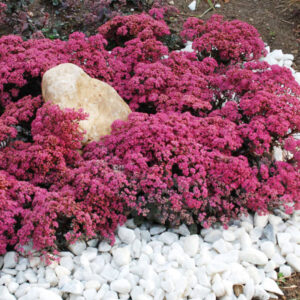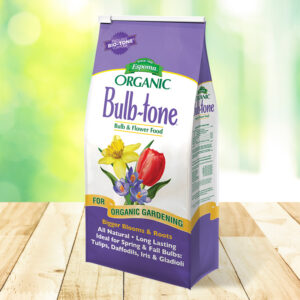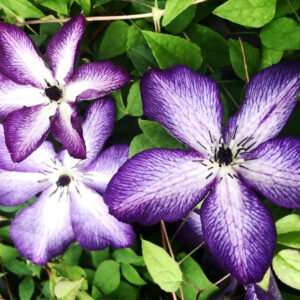Why aren’t my flowers blooming? This is a question homeowners and gardeners ask every year. We often plant bulbs and perennials for their beautiful flowers. However, some plants are grown for their interesting foliage. If you want to incorporate more foliage plants in your garden check out this article. If flowers are what you are aiming for it can be awfully frustrating when they don’t bloom.
The question of “Why aren’t my flowers blooming?” doesn’t have a straightforward answer. Asking questions will help you answer this question. In addition to asking more questions, note that each different type of plant may have a different reason for the lack of blooms. Therefore, I won’t be able to solve every “Why aren’t my flowers blooming?” question. But, I will be able to provide you the questions you need to try and determine why your flowers aren’t blooming.
Questions to Ask When Your Flowers Aren’t Blooming
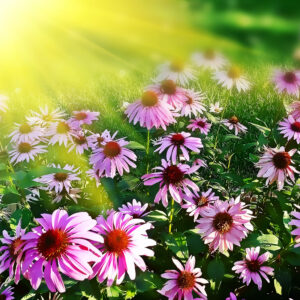
Questions About Sun Exposure
- How much sun does this plant need?
- How much sun does this plant receive?
- What time of day does this plant get sun?
- Does the plant nearby get a little more sun than this plant?
Observing your garden is critical in determining why your plants are behaving a certain way. Observing the amount of light your plants get can be very helpful in answering questions relating to sun and blooms.
“How much sun does this plant need?”
How much sun does this plant need is useful to know prior to planting. Plant sun-loving plants in locations that receive 8 hours or more of direct sun a day. Plants that need full sun and are planted in part shade to shade areas won’t perform as normal, and may not produce flowers. Bulbs and perennials that like shade may burn out in sun and the flowers may not last as long. Some plants may need to be moved after planting if they aren’t getting the appropriate amount of sun.
“How much sun does this plant receive?”

Sun exposure will vary depending on the time of the year. In spring some flowers may get more sun than they do in summer because the trees don’t have all their leaves in spring. Therefore, that area will have more sun in spring than in summer when the trees have all their leaves.
Starting a garden journal can be helpful to document your observations in the garden about the sun each area gets different times of the year, as well as different times of the day. Consider this: an area you observed in spring or fall may appear to get more sun than it does because there weren’t as many leaves on the trees. It is important to document the sun in your yard throughout the year.
“What time of day does this plant get sun?”
The morning sun will have a different impact on your flowers compared to the afternoon sun. Flowers that like part shade benefit from being planted in the morning sun. The morning sun is a gentle sun that low light plants tolerate better. The hot afternoon sun is required for certain plants like dahlias, canna lilies, and sedum. Knowing when the sun hits your planting beds is helpful to plant the right plant in the right place.
“Does the plant nearby get a little more sun than this plant?”
You may have a grouping of plants and the plants on a certain end of the bed don’t bloom or bloom much later than the other plants. It may not seem likely that within a 5’ space that amount of sun can make a difference, but it does. If the plant on the end of the group gets an hour or two less of sun a day based on location and shading from objects or plants this will have an impact on the blooms. Plants as close as 12″ from each other can bloom at different times, and may also produce more or fewer blooms than their neighboring plants.
Questions About Planting Location and Technique
- Was the bulb or root planted at the proper depth?
- Does my hardiness zone provide the right temperatures for flower buds to be produced on this plant?
- Did I plant this bulb at the right time of year?
“Was the bulb or root planted at the proper depth?”
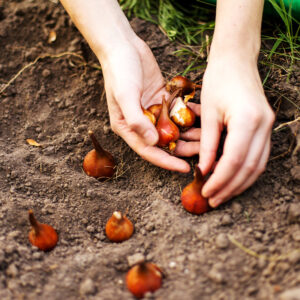
Planting depth is important for all items you grow. If a tree is planted too deep it can lead to crown rot. Planting too deep can also happen with perennials and shrubs. Planting fall bulbs like tulips, crocus, hyacinths, and daffodils too shallow can result in stunted blooms. Improper planting depth can also lead to less consistent blooms year after year.
In general, it is better to plant trees, shrubs, perennials, and annuals at or above the soil level. Most fall-planted bulbs grow best when planted at the suggested planting depth. Planting fall bulbs slightly deeper is usually better than planting them too shallow. Certain bulbs and perennials are rather sensitive to planting depth, and if they are not planted properly, they will not bloom.
Two examples of perennials sensitive to planting depth are bearded iris and peonies. Plant bearded iris 1-2” deep, with about 50% of the rhizome showing above ground level. Peonies should be planted ½”-2” below the soil. If peony roots or bearded iris rhizomes are planted too deep they will not bloom.
“Does my hardiness zone provide the right temperatures for flower buds to be produced on this plant?”
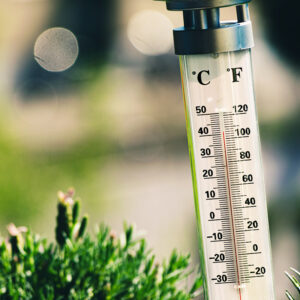
Hardiness zone dictates whether a certain item will grow as a perennial in your climate. It also can determine whether or not the item will bloom in your zone.
Tulips are a great example of flowers that will grow in warmer climates but often won’t produce a flower bud. Tulips require cold temperatures in order to produce a flower bud. If tulips don’t have at least 12-16 weeks of temperatures below 50 degrees during the day, they won’t produce a flower bud. Therefore, tulips may grow leaves in a zone 8 Georgia, California, or Alabama. If the cold temperatures are not provided, tulips will not produce a flower bud.
Hardiness zone can also affect buds forming in cold climates. The leaves, stems, and roots of a plant are hardy in a cold climate, but the flower buds aren’t hardy. The plant will grow but will not bloom if the weather is too cold.
“Did I plant this bulb at the right time of year?”
Certain bulbs need to be planted at specific times of the year. A couple types of bulbs such as lilies or peonies can be planted in either the spring or fall planting season. As mentioned above tulips and other fall-planted bulbs need cold temperatures in order to produce a flower bud, therefore they are planted in fall or early winter.
Occasionally you may be able to find tulip bulbs in spring that are leftover from last fall, or perhaps you forgot to plant some bulbs last fall and find them in your shed in April. They can certainly be planted in spring; however, they won’t bloom until the following spring when they have received the cold temperatures they require.
Questions About How the Plant is Cared For
- Was fertilizer used on this plant? If so when and what kind?
- Was this plant pruned or trimmed?
“Was fertilizer used on this plant? If so when and what kind?”
Fertilizer can seem like the magic potion for blooms. While fertilizing your plants so that they have the proper nutrients is important, fertilizing for blooms is not always cure-all to your flowers not blooming. For example, some plants like Trumpet Vine do not like fertilizer, specifically fertilizer high in nitrogen. Trumpet vine is not able to take up nitrogen in a productive way and will result in excessive green growth and few blooms.
Plants that are grown from a flower bulb have all their energy stored in the bulb. The energy for growth and blooms is produced and stored when the bulb is dormant. Therefore, flower bulbs naturally hold an incredible amount of energy to produce a flower bud. However, if there is not enough energy stored in the flower bud a bulb fertilizer such as Espmoa Bulb Tone is beneficial to add to new and existing bulb plantings to ensure you have blooms on your flowers.
“Was this plant pruned or trimmed?”
Pruning techniques and trimming can have an impact on the blooms that are produced. For certain trees and shrubs, the buds are produced on old wood. This means the buds were formed on the last season’s growth, therefore you don’t want to trim or prune the shrub before it blooms in spring or summer. Clematis vines are another plant whose buds are produced on old wood, new wood, or both. Different types of clematis will require pruning at different times. Typically you can find clematis pruning information at the time of purchase.
Spring-blooming flowers such as tulips and daffodils can also be impacted by trimming and the removal of leaves. It is best to keep the leaves intact until they are yellow and withered. The leaves are gathering energy through the sun for next year’s blooms. Removing the leaves too early will prevent the bulb from gathering the energy they need and can be a reason your tulips and other spring-blooming bulbs aren’t blooming.
Before snipping or pruning your bulbs, perennials, trees, and shrubs it is best to find out if there are any special requirements for that particular plant.
Knowledge is the Key to Finding out Why Your Flowers Aren’t Blooming
When you plant flower bulbs in fall and wait all spring it sure is disappointing to miss out on the blooms. Perhaps you spent a hot day in the garden in late spring or early summer with dreams of a bevy of blooms to enjoy later in summer. Plants often behave in ways we don’t always understand. With more knowledge about the flowers you plant you may start to understand why your flowers aren’t blooming. Dig deep, ask questions and you may find ways to get your flowers to bloom all season!


